How to Make a Digital Art Portfolio in 2024 to Showcase Your Art Online
A digital art portfolio showcases your creativity and skills for everyone to see. It is a great starting point for digital artists to grow as professionals in the art world.
In this article, we’ll discuss the importance of a digital art portfolio, how to create one, and provide inspiring examples. Whether you’re a beginner or want to enhance your existing portfolio, this guide offers practical steps and creative ideas.
Download website launch checklist
Why Create a Digital Art Portfolio
Having a digital art portfolio is essential for the artist. For starters, it helps build your credibility with potential clients. It is a great way to promote and show your art skills online.
A digital portfolio is beneficial if you’re looking to open commission work. It allows you to reach an international audience, demonstrate your skills, and justify your pricing if needed.
Furthermore, an online portfolio connects you with other digital artists and art communities. This connection can lead to collaborations with other artists, brands, and even opportunities to be hired by an agency.
If you’re worried that building a website is a hassle, you’ve come to the right place. This article will teach you how to use Hostinger Website Builder to build your digital art portfolio easily and quickly.
How to Make a Digital Art Portfolio
This guide will help you build a digital portfolio to highlight your talent and connect with your target audience.
1. Choose a Platform
There are plenty of great platforms to build your portfolio, including website builders that offer customizable templates and responsive designs.
Hostinger Website Builder is an all-in-one solution allowing you to build your digital art portfolio professionally without any technicalities.
With just $2.49/month, you can enjoy features such as:
- AI builder. Avoid the lengthy process of building from scratch by using AI to build your portfolio website in under two minutes.
- Drag-and-drop editor. Easily customize elements without any coding.
- Secure web hosting. Protect your creation with unlimited free SSL and automatic data backups.
- eCommerce features. Add an online store to your art portfolio and sell up to 500 products.
- SEO tools. Optimize your online portfolio for search engines with the SEO tools and settings within the builder.
- Marketing integration. Use third-party tools such as Google Analytics, Facebook Pixel, Google AdSense, and many more.
2. Purchase the Website Builder Plan
To start setting up your portfolio, purchase the web hosting plan that comes with a free Website Builder and choose the payment terms that suit you best.
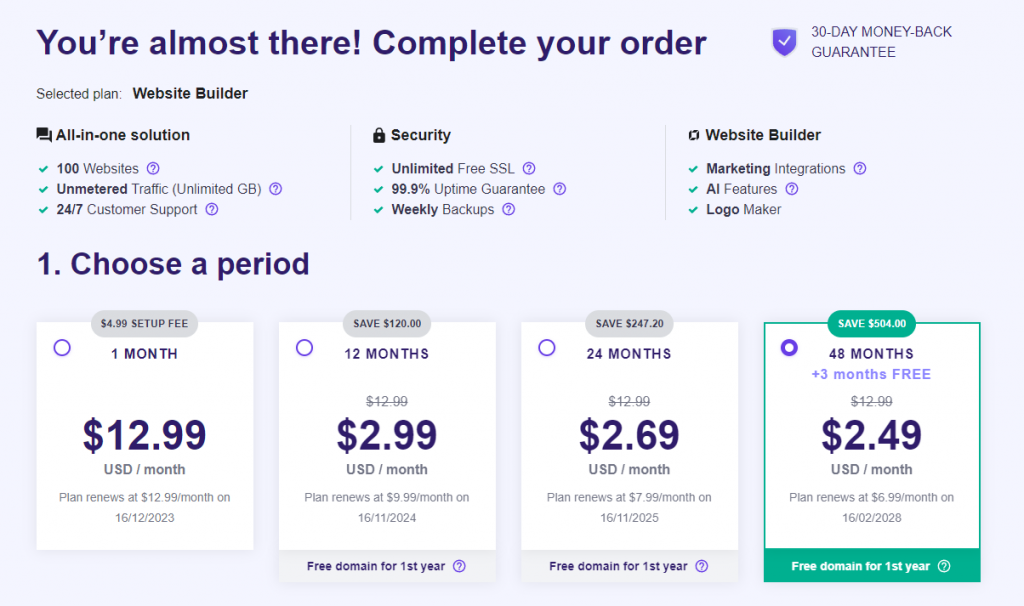
Choosing this plan allows you to save time and money because everything is on one platform.
Pro Tip
Choose a plan period of 12 months or longer to get a free custom domain for your digital portfolio.
3. Create Your Digital Art Portfolio With AI Builder
Creating a digital art portfolio with the AI builder takes just a few minutes with the help of a guided setup:
- On the setup page, answer questions about who is creating the website and what type of website it will be.
- Select the create a website option and choose the website builder as your platform.
- Name your digital portfolio. You can claim a free domain or connect an existing domain if you have one. When you claim a free domain, you will be taken to the name selection page, where you can also check the domain availability and choose a domain extension. It’s a great idea to opt for a .digital domain name, as it perfectly aligns with the digital nature of your work, making it more memorable and relevant to your audience.
- Confirm the domain name. You will be directed to the AI builder to start creating your online art portfolio.
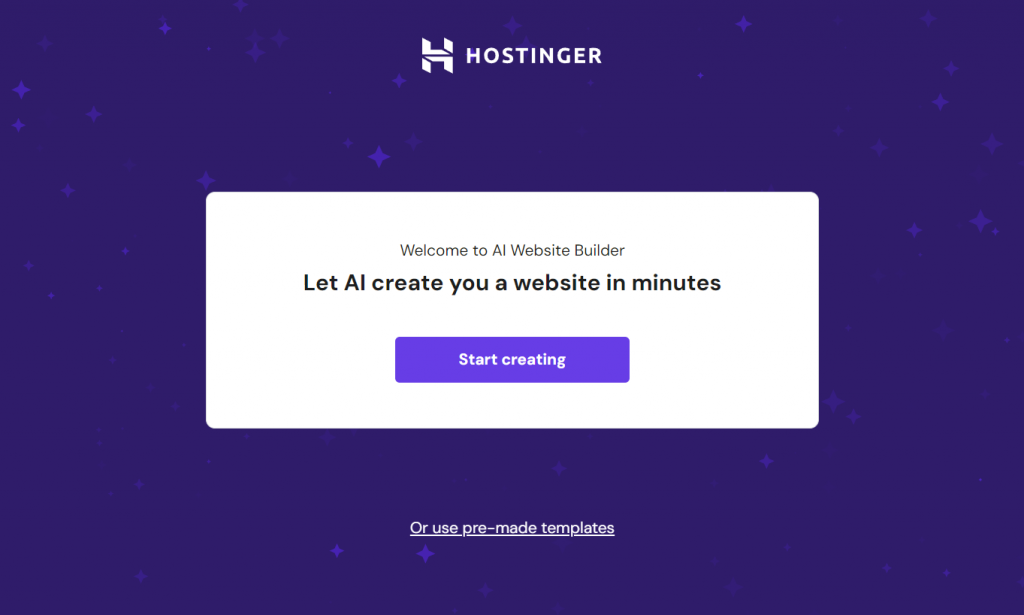
- Enter your brand name, website type, and description for the AI to create the portfolio. When adding the description, be sure to add two to three sentences about what you do to help AI generate unique website content for you.
Once all is done, AI will create an online portfolio based on the information. The portfolio will have relevant text descriptions, image placements, and pages for a digital art portfolio. These include the art portfolio, About Me, and Contact pages.
4. Customize Your Portfolio
Enhance what the AI builder generated and start personalizing your art portfolio to match your art style and personal branding. This will help you connect with your target audience.
To help the customization process, the builder includes a checklist from start to finish, which consists of the following:
- Edit heading text
- Update images
- Edit paragraph text
- Update logo
- Update social media icons
- Preview the online portfolio for mobile layout
For further customization, consider adding additional pages, such as a blog, to share your art journey. Don’t forget to pick your fonts and keep a consistent style throughout your portfolio.
Also, take time to pick a color scheme that resonates with your art style. The AI builder allows you to customize the colors of your online art portfolio. You can adjust the color value from the color picker or type it in directly.
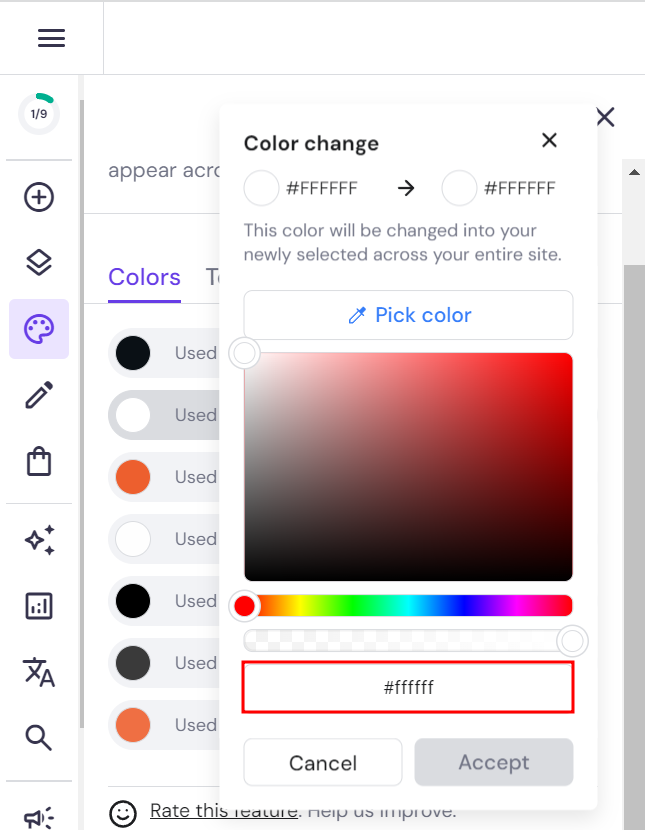
For more guidance, check out our tutorial on how to design a website.
5. Add Artwork
Showcasing your highest-quality images allows your digital art portfolio to stand out among other online platforms. They must be uploaded in the correct size for optimal display.
Add as much artwork to your portfolio as possible, starting with your latest projects. This highlights what you are currently working on and demonstrates your evolving skills.
Next, include your proudest achievements. These pieces define your journey as a digital artist and resonate the most with you. They often stand out to viewers as well.
Finally, consider grouping your artwork by project. This organization helps viewers understand the context of each piece and the progression of your ideas in each project.
6. Write Captivating Descriptions
Captivating image descriptions help explain your artwork and projects. They also help optimize your digital portfolio for search engines and drive traffic to it.
When writing descriptions for online art portfolios, your tone of voice should reflect your personality and artistic style. This creates a consistent experience for your viewers as they browse your work.
Include relevant keywords that focus on a central idea for each piece. Expanding on this idea helps convey the message behind your artwork, making it more relatable to the target audience.
Next, engage in storytelling and a background story. This approach brings each piece of art to life, providing context and depth. You are not just displaying your art but also offering insights into the concept, inspiration, and process behind it.
If you’re unsure where to start, use the AI Writer tool that comes with Hostinger Website Builder. After choosing a topic and category, it will recommend text options for your descriptions.
7. Organize Your Portfolio
Categorizing your portfolio is crucial for easy navigation and user experience. This adds a professional touch to your portfolio, which can be appealing to potential employers or collaborators.
As with your image descriptions, storytelling can effectively structure your digital art portfolio. Start with a compelling landing page that introduces viewers to your work.
Hostinger Website Builder provides theme layouts and page structures as a source of inspiration to design your portfolio. These tools are designed to help you effectively showcase your work in a cohesive and visually appealing manner.
8. Showcase Your Portfolio
The final step before going live is to preview your digital portfolio. Check how each page appears on different devices, ensuring compatibility and a seamless user experience across all platforms.
Once you’re satisfied with how everything looks, it’s time to publish your portfolio. After that, you can start promoting your art portfolio and sharing it on social media platforms.
Pro Tip
Avoid making changes immediately after publishing your portfolio. Google crawls and indexes websites to appear on the search result page. Making a change in your website can disrupt this process.
To share your portfolio on social media, start by creating posts highlighting your best work or new additions to your portfolio. Use the best-quality image from your portfolio and link back to your site.
Engage with your followers by sharing stories or insights about your art. Utilize relevant hashtags and consider tagging art communities or platforms to increase visibility.
Regularly updating your social media with content from your portfolio keeps your audience engaged and drives traffic to your online portfolio.
Inspiring Digital Art Portfolio Examples
Here are five examples to help you get art portfolio design ideas. The first three portfolios are built with Hostinger Website Builder, giving you a glimpse of what’s possible with the builder.
1. Rhienon
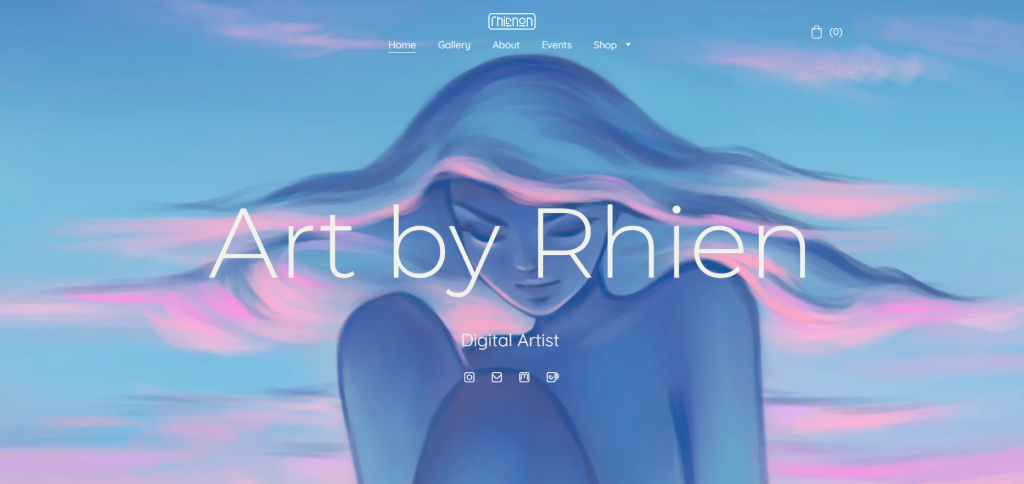
Art by Rhien presents a simple yet effective digital art portfolio that serves as an excellent inspiration for digital artists.
Digital artist Rhianna makes a strong first impression by using a large, eye-catching piece of her artwork as the background for her portfolio. This strategy immediately draws visitors in with Rhianna’s style and skill right from the start.
Her portfolio gallery is sleek and simple, using a white background that helps emphasize her artwork without distractions.
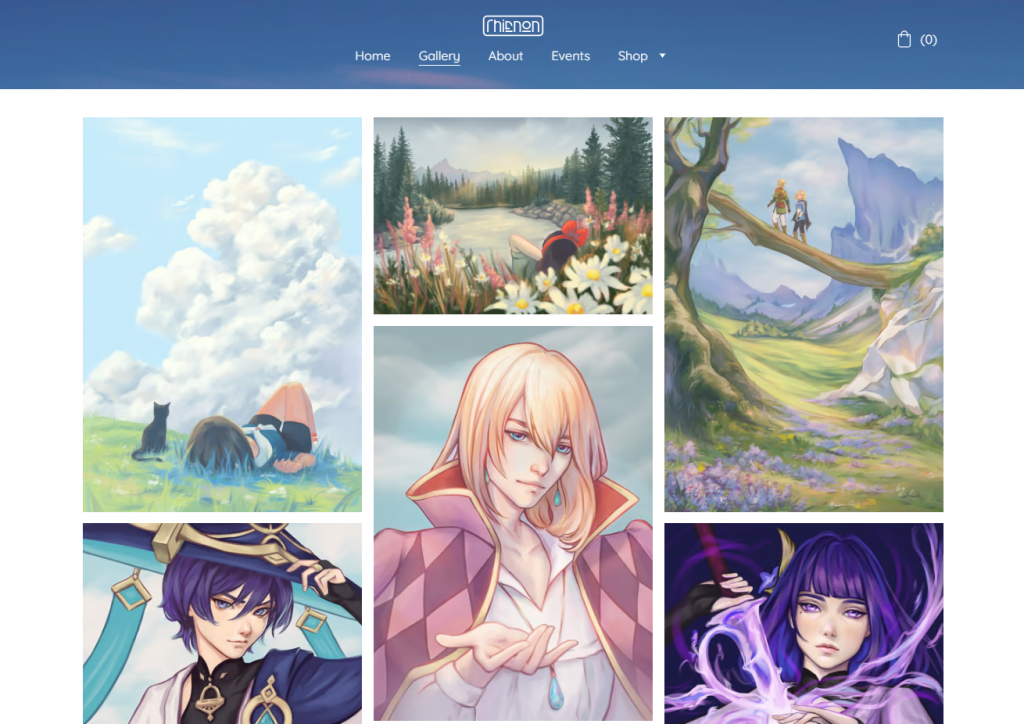
An interesting feature of her portfolio is the inclusion of an Events page. The page highlights upcoming events, exhibitions, or art fairs she’s involved in. It’s a great way to promote her participation in the art community and invite followers to see her work in person.
2. Fett Burger
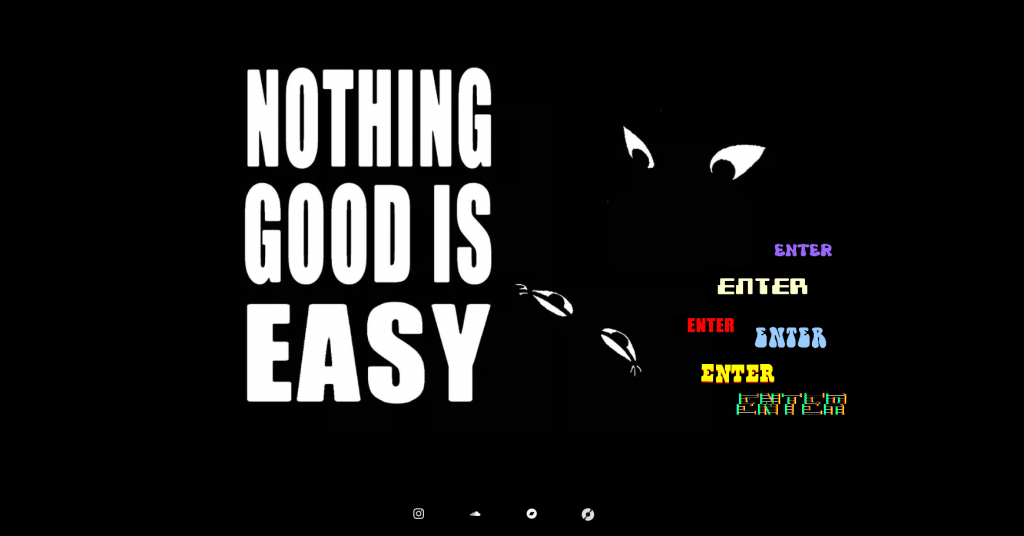
Fett Burger is an artist whose online portfolio reflects their unique and bold artistic style. The landing page has a prominent one-liner, complemented by a contrasting, playful array of “Enter” buttons that entice readers to click.
A striking aspect of Fett Burger’s portfolio is the use of bold typography colors, styles, and animation that stand out against the black background. This unique approach demonstrates how artists can creatively use web design to mirror their artistic style and vision, making their portfolio a memorable visitor experience.
Fett Burger’s portfolio also includes a simple yet effective About Me page. This page provides a clear and concise insight into the artist’s background and artistic journey, helping visitors connect more personally with the artist.
3. The Indy Sign
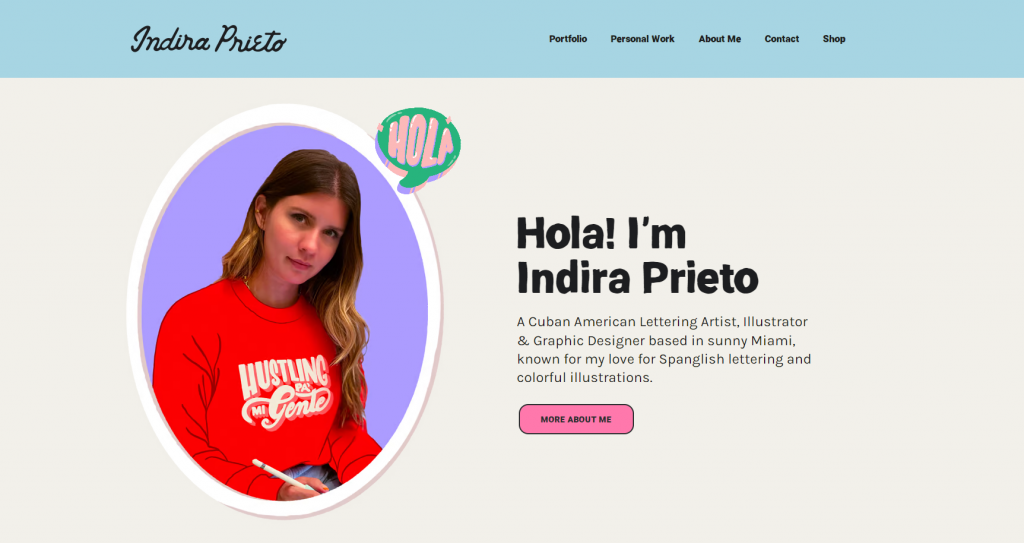
Indira Prieto, a talented digital illustrator, stands out for her strong personal branding on her portfolio website. Prieto embraces her Spanish identity by incorporating elements like a cheerful display of “Hola!” and lush floral graphics.
The website’s background color creates a seamless visual experience, enhancing the presentation of her artwork. Her portfolio page facilitates a straightforward presentation of artworks categorized by project collection.
Built with Hostinger Website Builder, Prieto’s portfolio skillfully blends both her professional and personal artwork, providing a comprehensive art gallery walk-through for visitors to explore her diverse creations in one place.
4. Pine Bones
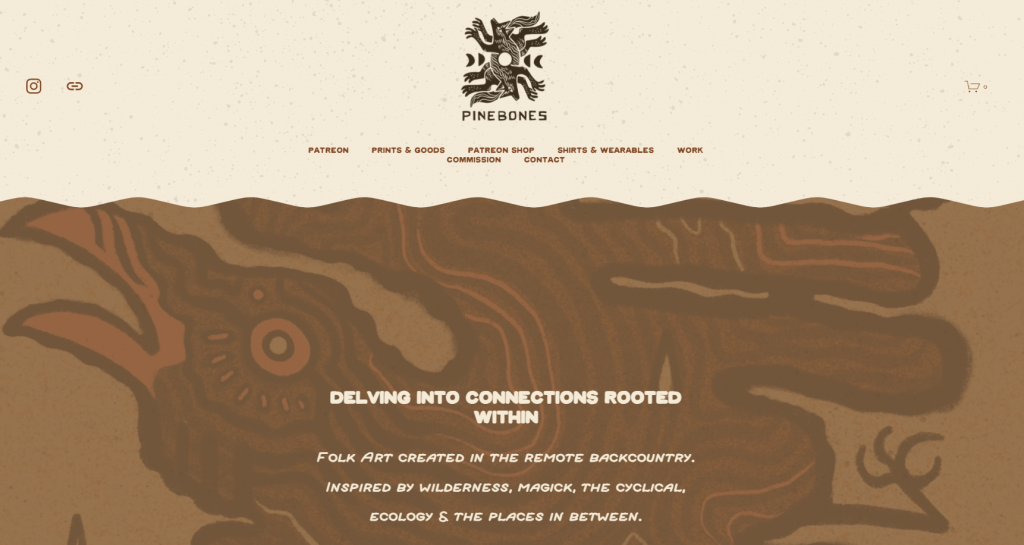
Pine Bones’s digital portfolio exemplifies a well-rounded and comprehensive showcase of their work. It is a vivid example of effectively presenting art in an online space.
What makes Pine Bones’s portfolio inspiring is the consistent use of colors and design elements throughout the site. This consistency makes the site visually appealing and helps create a solid and recognizable brand identity.
Additionally, the Shop and Commission pages are designed thoughtfully to appeal to potential buyers. It is user-friendly and showcases the artworks for sale in a way that is easy to browse and understand.
5. Jason Chan Art
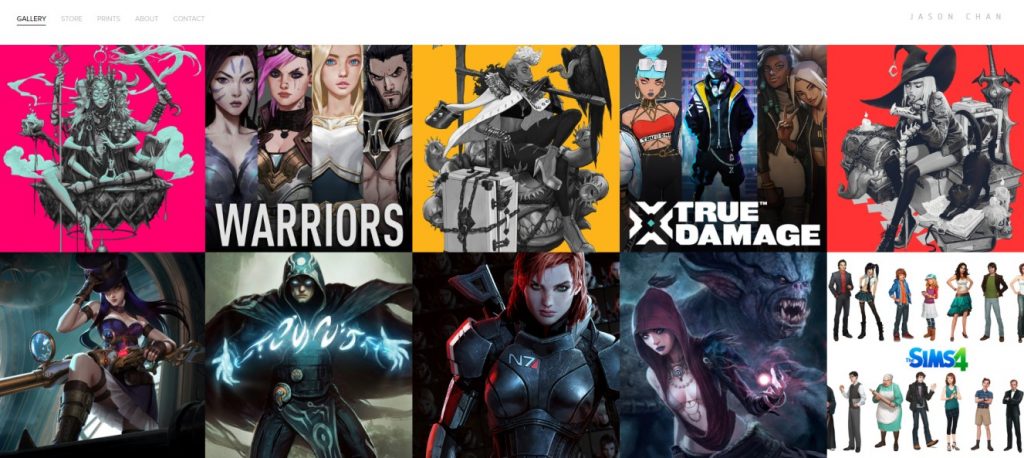
Jason Chan is a principal visual development artist at Riot Games. As a professional artist, he works with traditional mediums like oil paints and digital tools such as Photoshop and Illustrator.
His digital art portfolio design showcases his work front and center, categorizing his extensive gallery by game titles directly on the homepage. The user experience is enhanced by a clean navigation bar that directs visitors to his Store, Prints, About section, and Contact details.
This art portfolio website is an excellent model for illustrators looking to highlight their work and offer easy exploration of their collections.
Suggested Reading
Discover more art portfolio website examples to get inspired by.
Conclusion
Creating a digital art portfolio is essential for any digital artist looking to showcase their work, connect with audiences, and attract potential clients or collaborators. It is a professional platform to display your artistic journey, achievements, and unique style.
Building your digital art portfolio involves eight key steps:
- Choose a platform
- Set up your portfolio
- Choose a template
- Customize your portfolio
- Add artwork
- Write captivating descriptions
- Organize your portfolio
- Showcase your portfolio
For inspiration, refer to the five examples of digital art portfolios. Take note of how each artist structure their digital art portfolios, display their artwork, and reflect their unique styles.
Remember, your digital art portfolio is a dynamic representation of your work. Regular updates and personal touches will keep it fresh and engaging, reflecting your growth as an artist.
How to Make a Digital Art Portfolio FAQ
Let’s explore the most commonly asked questions about a digital art portfolio.
What Should I Include in My Digital Art Portfolio?
Include artist profile, art portfolio with high-quality images, and contact info for a well-rounded digital art portfolio. Additionally, share your artistic journey and noteworthy accomplishments to personalize your portfolio.
Can I Update My Digital Art Portfolio Over Time?
Yes. Hostinger Website Builder offers a simple online portfolio update process. You can easily add new artwork, edit existing ones, or rearrange your own portfolio layout with just a few clicks.
This flexibility ensures your portfolio stays up-to-date, keeping it fresh for potential clients and showcasing your latest works with minimal hassle.
Can I Sell My Artwork Directly From My Digital Art Portfolio?
Absolutely! You can transform your art portfolio website into an online marketplace for your creations. With Hostinger Website Builder, it’s as easy as adding a new page to your own website. Display your artwork with high-quality images, descriptions, and prices. Include a secure payment gateway for transactions.


